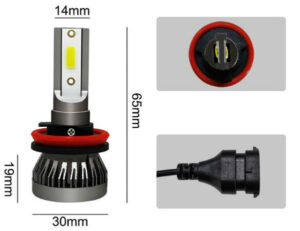The Bright Future of Advanced Automotive Headlights Technology
The advanced technology encompasses every part of modern cars, even those that seem too simple to upgrade, like headlights. The integral part of any vehicle ensures your safety on the road, has different utility functions, and adds character to the overall design. Your Car’s headlights may only seem trivial, and there is, in fact, more room for improvement.
And lately, the automotive manufacturers have let their imaginations run wild with all the amazing things that can be done to car lighting. Due to the variety of LED and HID kits, conversion to brighter headlights may get tricky. So before upgrading your headlights, it is better to look up the correct bulb (part number) that will fit your vehicle.
How Automotive Headlights are the Smart
Today’s most broadly adopted innovation is called smart headlights or adaptive driving beams, ADB for short. As the name implies, these headlights are “smart” enough to dynamically adapt the beams, their brightness, shape, and even direction depending on the conditions and environment. Their creation was inevitable. We want our headlights to be as bright and far-reaching as possible, but that should not be done at the expense of other drivers and pedestrians alike. Unfortunately, not all drivers are conscientious enough to tune down their high beams when necessary, you have been blinded so many times by the oncoming traffic. Hopefully, with more ADB headlights on the road, this issue will become a thing of the darker past.
Matrix Automotive Headlights: Revolutions
The next cool technology is for the people who chose the red pill and discarded boring automotive lighting stereotypes. The first company to introduce this technology was Audi. In 2013 they started to develop and popularize this unique technology. The matrix headlights are built differently from the standard assemblies. They consist of clusters of somewhat independent LEDs, hence the other name, pixel lighting.
The key principle of this technology is to detect light sources such as headlights and tail lights of other vehicles and temporarily deactivate particular elements of the cluster. So ideally, they should illuminate the unoccupied parts of the road ahead while mostly omitting the other cars. This helps to avoid blinding the drivers and still gives you the same brightly lit distance as if nothing was blocking it.
Ford’s Image-Projecting Automotive Headlights
Self-correcting beams are great, but that is not the end of the headlight manufacturers’ creativity and capacity. Meet the newest feature the headlights have ever had – projecting simple images on the road. This technology, unlike the previous two, is not yet accessible, however. The brave developers at Ford decided to simultaneously make your headlights an extension of the dashboard and the infotainment system. This system is supposed to make the driving experience even safer in the future. By projecting the warning signs about the road conditions caused by weather and traffic, this innovation will be the first thing that informs you about possible difficulties on your way. It is still too early to make any predictions about its usability, but it has made an impact on the automotive world we know, getting your car a step closer to the sci-fi image of the future.
Laser Automotive Beam Headlights
Unfortunately, these are not the laser beams you see in Star Wars, but they are amazing in their way. The light you see from these laser headlights does not come from a laser itself. Instead, it is produced inside the headlight assembly with the laser diode and chemicals like phosphor, which is then reflected toward the road in a very bright wide beam we are accustomed to.
It is hard to imagine something more energy efficient than our well-known LED lights, so bright that people still question their legality. However, the laser beam headlights managed to beat them in the energy efficiency and brightness fair and square. The density of the beam is also no joke. It can project light to around 600 meters ahead, which is twice as much as its LED counterparts. As with any developing technology, it still needs more refinement, though. Despite the tremendous efficiency and low burning temperature, it remains the priciest option so far. And the vulnerability to vibration is still an issue.
How Put GPS in Car’s Headlights
The most amazing thing about technology is that you sometimes can never guess what bizarre combinations it can create. We are used to the GPS in our cars and smartphones, aboard ships and planes alike. But have you ever heard about headlights using GPS? As crazy as this may sound, such a combination makes a lot of sense if you look closer at how it all works.
Installing the headlights that change direction depending on your steering is good. But that is not always enough to illuminate complex road intersections, roundabouts, and places with crazy turns. This is where the GPS headlight technology truly shines. The GPS road map and cameras help your headlight adjust in time, granting you a perfect illumination of all the turns and corners. One headlight will focus on the road ahead, leading you where you are supposed to go, while the other will effectively illuminate the parts of the road where you can encounter more drivers, cyclists, and pedestrians.
Automotive Bottom Line
As wonderful and sometimes bizarre as the innovations may be, there are always some drawbacks in the early stages. Some technologies are only being tested, while others are only perfect in their promotion videos. Regardless of that, each new feature brings us closer to a brighter future, hopefully. And even if you get these new super-efficient features for your car, it’s always best to check if they are already legal. Safety always comes first, so texting and approving can really take a lot of time, and drive safely.
